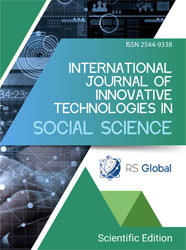SWIMMING AGAINST THE CURRENT: ASTHMA AND UPPER AIRWAY DISORDERS IN COMPETITIVE SWIMMERS
Abstract
Purpose of the research: This review aims to assess the frequency of asthma and upper airway disorders in competitive swimmers, as well as identify potential environmental and training factors that contribute to the development of these conditions.
Materials and methods: The review of research literature was conducted through databases such as PubMed, Google Scholar, and Scopus, including studies from 2007 to 2025.
Results: Competitive swimmers have been shown to have a significantly higher incidence of exercise-induced asthma and chronic upper respiratory tract syndromes than in the general population. Particularly frequently observed cough, nasal congestion, wheezing, and bronchial hyperresponsiveness. There was also a correlation between the length of exposure to the swimming pool environment and the severity of the symptoms.
Conclusions: The environment of indoor swimming pools, especially exposure to chlorination byproducts, may contribute to the development of asthma and chronic upper respiratory tract diseases in swimmers. There is a need for further research and implementation of preventive measures, such as improving swimming pool ventilation and monitoring the health of athletes.
References
Boraczyński M, Balcerek T, Rożkiewicz N, Pabiszczak M, Harasymczuk M, Sławska A, Lutomski P. Pulmonary function in swimmers exposed to disinfection by-products: a narrative review. Front Physiol. 2025 Jan 6;15:1473302. doi: 10.3389/fphys.2024.1473302. PMID: 39835195; PMCID: PMC11743734. https://doi.org/10.3389/fphys.2024.1473302
Cavaleiro R. J., Paciência I., Silva D., Martins C., Madureira J., Oliveira Fernandes E., et al. (2018). Swimming pool exposure is associated with autonomic changes and increased airway reactivity to a beta-2 agonist in school aged children: a cross-sectional survey. PLoS One 13 (3), e0193848. doi:10.1371/journal.pone.0193848
Bougault V., Turmel J., Levesque B., Boulet L. P. (2009). The respiratory health of swimmers. Sports Med. 39, 295–312. doi:10.2165/00007256-200939040-00003
Belda J., Ricart S., Casan P., Giner J., Bellido-Casado J., Torrejon M., et al. (2008). Airway inflammation in the elite athlete and type of sport. Br. J. Sports Med. 42 (4), 244–248. doi:10.1136/bjsm.2007.036335
Jacobs J. H., Spaan S., van Rooy G. B., Meliefste C., Zaat V. A., Rooyackers J. M., et al. (2007). Exposure to trichloramine and respiratory symptoms in indoor swimming pool workers. Eur. Respir. J. 29 (4), 690–698. doi:10.1183/09031936.00024706
Proulx, H., & Hallé, S. (2022). A numerical study of the impacts of outdoor air intake and air changes per hour on the trichloramine concentrations in a swimming pool enclosure. Frontiers in Built Environment, 8, 957973. https://doi.org/10.3389/fbuil.2022.957973
Cavestri, R. C., and Seeger-Clevenger, D. (2008). Chemical off-gassing from indoor swimming pools. ASHRAE Res. Proj. Rep. RP- 1083, 39.
Nitter TB, Grande MS, Svendsen KVH, Jørgensen RB, Carlucci S, Cao G. Can CO2 sensors in the ventilation system of a pool facility help reduce the variability in the trihalomethane concentration observed in indoor air? Environ Int. 2020 May;138:105665. doi: 10.1016/j.envint.2020.105665. Epub 2020 Mar 19. PMID: 32200313.
Cheema WA, Kaarsholm KMS, Andersen HR. Combined UV treatment and ozonation for the removal of by-product precursors in swimming pool water. Water Res. 2017 Mar 1;110:141-149. doi: 10.1016/j.watres.2016.12.008. Epub 2016 Dec 10. PMID: 28006704.
Pai CW, Wang GS. Treatment of PPCPs and disinfection by-product formation in drinking water through advanced oxidation processes: Comparison of UV, UV/Chlorine, and UV/H2O2. Chemosphere. 2022 Jan;287(Pt 3):132171. doi: 10.1016/j.chemosphere.2021.132171. Epub 2021 Sep 8. PMID: 34537457.
Lomax M. Airway dysfunction in elite swimmers: prevalence, impact, and challenges. Open Access J Sports Med. 2016 May 12;7:55-63. doi: 10.2147/OAJSM.S88339. PMID: 27274324; PMCID: PMC4869851.
Pedersen L, Winther S, Backer V, Anderson SD, Larsen KR. Airway responses to eucapnic hyperpnea, exercise, and methacholine in elite swimmers. Med Sci Sports Exerc. 2008 Sep;40(9):1567-72. doi: 10.1249/MSS.0b013e31875719a.
Bougault V, Turmel J, Boulet LP. Airway hyperresponsiveness in elite swimmers: is it a transient phenomenon? J Allergy Clin Immunol. 2011 Apr;127(4):892-8. doi: 10.1016/j.jaci.2010.11.003. Epub 2010 Dec 16. PMID: 21167573.
Helenius I, Rytilä P, Sarna S, Lumme A, Helenius M, Remes V, Haahtela T. Effect of continuing or finishing high-level sports on airway inflammation, bronchial hyperresponsiveness, and asthma: a 5-year prospective follow-up study of 42 highly trained swimmers. J Allergy Clin Immunol. 2002 Jun;109(6):962-8. doi: 10.1067/mai.2002.124769a. PMID: 12063525.
Agnieszka Włodyka-Bergier & Tomasz Adam Bergier & Emilia Stańkowska, 2025. "The Role of Hygiene in a Sustainable Approach to Managing Pool Water Quality,"Sustainability, MDPI, vol. 17(2), pages 1-17, January.
Andersson, M., Backman, H., Nordberg, G. et al. Early life swimming pool exposure and asthma onset in children – a case-control study. Environ Health 17, 34 (2018). https://doi.org/10.1186/s12940-018-0383-0
Beretta S, Vivaldo T, Morelli M, Carlucci P, Zuccotti GV. Swimming pool-induced asthma. J Investig Allergol Clin Immunol. 2011;21(3):240-1. PMID: 21548454.
Bougault V, Boulet LP. Is there a potential link between indoor chlorinated pool environment and airway remodeling/inflammation in swimmers? Expert Rev Respir Med. 2012 Nov;6(5):469-71. doi: 10.1586/ers.12.51. PMID: 23134238.
Voisin C, Sardella A, Marcucci F, Bernard A. Infant swimming in chlorinated pools and the risks of bronchiolitis, asthma and allergy. Eur Respir J. 2010 Jul;36(1):41-7. doi: 10.1183/09031936.00118009. Epub 2010 Jan 14. PMID: 20075053.
Aho R, Hirn J. A survey of fungi and some indicator bacteria in chlorinated water of indoor public swimming pools. Zentralbl Bakteriol Mikrobiol Hyg B. 1981;173(3-4):242-9. PMID: 7304014.
Rezaei N, Dabiri S, Getso MI, Damani E, Modrek MJ, Parandin F, Raissi V, Yarahmadi M, Shamsaei S, Soleimani A, Amiri S, Arghavan B, Raiesi O. Fungal contamination of indoor public swimming pools and their dominant physical and chemical properties. J Prev Med Hyg. 2022 Jan 31;62(4):E879-E884. doi: 10.15167/2421-4248/jpmh2021.62.4.1594. PMID: 35603246; PMCID: PMC9104683.
Hurraß J, Heinzow B, Aurbach U, Bergmann KC, Bufe A, Buzina W, Cornely OA, Engelhart S, Fischer G, Gabrio T, Heinz W, Herr CEW, Kleine-Tebbe J, Klimek L, Köberle M, Lichtnecker H, Lob-Corzilius T, Merget R, Mülleneisen N, Nowak D, Rabe U, Raulf M, Seidl HP, Steiß JO, Szewszyk R, Thomas P, Valtanen K, Wiesmüller GA. Medical diagnostics for indoor mold exposure. Int J Hyg Environ Health. 2017 Apr;220(2 Pt B):305-328. doi: 10.1016/j.ijheh.2016.11.012. Epub 2016 Dec 5. PMID: 27986496.
Arlian LG. Water balance and humidity requirements of house dust mites. Exp Appl Acarol. 1992 Nov;16(1-2):15-35. doi: 10.1007/BF01201490. PMID: 1493744.
Chowdhury S, Alhooshani K, Karanfil T. Disinfection byproducts in swimming pool: occurrences, implications and future needs. Water Res. 2014 Apr 15;53:68-109. doi: 10.1016/j.watres.2014.01.017. Epub 2014 Jan 21. PMID: 24509344.
Exercise-Induced Asthma: Managing Respiratory Issues in Athletes. Ora J, De Marco P, Gabriele M, Cazzola M, Rogliani P. J Funct Morphol Kinesiol. 2024 Jan 3;9(1):15. doi: 10.3390/jfmk9010015. PMID: 38249092
Asthma, atopy, and exercise: Sex differences in exercise-induced bronchoconstriction. Rodriguez Bauza DE, Silveyra P. Exp Biol Med (Maywood). 2021 Jun;246(12):1400-1409. doi: 10.1177/15353702211003858. Epub 2021 Apr 1. PMID: 33794694
Asthma, allergies and respiratory symptoms in different activity groups of swimmers exercising in swimming halls. Päivinen M, Keskinen K, Putus T, Kujala UM, Kalliokoski P, Tikkanen HO. BMC Sports Sci Med Rehabil. 2021 Oct 4;13(1):119. doi: 10.1186/s13102-021-00349-2. PMID: 34607605
Mechanisms of asthma in Olympic athletes – practical implications T. Haahtela, P. Malmberg, A. Moreira First published: 25 April 2008 https://doi.org/10.1111/j.1398-9995.2008.01686.x
Couto, Mariana et al. “Health effects of exposure to chlorination by-products in swimming pools.” Allergy vol. 76,11 (2021): 3257-3275. doi:10.1111/all.15014
Bernard, A et al. “Outdoor swimming pools and the risks of asthma and allergies during adolescence.” The European respiratory journal vol. 32,4 (2008): 979-88. doi:10.1183/09031936.00114807
Fantuzzi, Guglielmina et al. “Prevalence of ocular, respiratory and cutaneous symptoms in indoor swimming pool workers and exposure to disinfection by-products (DBPs).” International jour
Bernard, A. “Chlorination products: emerging links with allergic diseases.” Current medicinal chemistry vol. 14,16 (2007): 1771-82. doi:10.2174/092986707781058940
Carbonnelle, Sylviane et al. “Changes in serum pneumoproteins caused by short-term exposures to nitrogen trichloride in indoor chlorinated swimming pools.” Biomarkers : biochemical indicators of exposure, response, and susceptibility to chemicals vol. 7,6 (2002): 464-78. doi:10.1080/13547500210166612
Shim, Ji-Su et al. “Aggravation of asthmatic inflammation by chlorine exposure via innate lymphoid cells and CD11cintermediate macrophages.” Allergy vol. 75,2 (2020): 381-391. doi:10.1111/all.14017
Mountjoy, Margo et al. “Prevalence and characteristics of asthma in the aquatic disciplines.” The Journal of allergy and clinical immunology vol. 136,3 (2015): 588-94. doi:10.1016/j.jaci.2015.01.041
Moreira, André et al. “Airway vascular damage in elite swimmers.” Respiratory medicine vol. 105,11 (2011): 1761-5. doi:10.1016/j.rmed.2011.05.011
Views:
29
Downloads:
17
Copyright (c) 2025 Weronika Sepioło, Ilona Boniakowska, Ilona Kamińska, Maria Wydra, Jakub Przerwa, Joanna Wąsik, Izabela Stachowicz, Eliza Gawron, Kacper Gryboś, Julia Samborska, Anna Łysik

This work is licensed under a Creative Commons Attribution 4.0 International License.
All articles are published in open-access and licensed under a Creative Commons Attribution 4.0 International License (CC BY 4.0). Hence, authors retain copyright to the content of the articles.
CC BY 4.0 License allows content to be copied, adapted, displayed, distributed, re-published or otherwise re-used for any purpose including for adaptation and commercial use provided the content is attributed.















